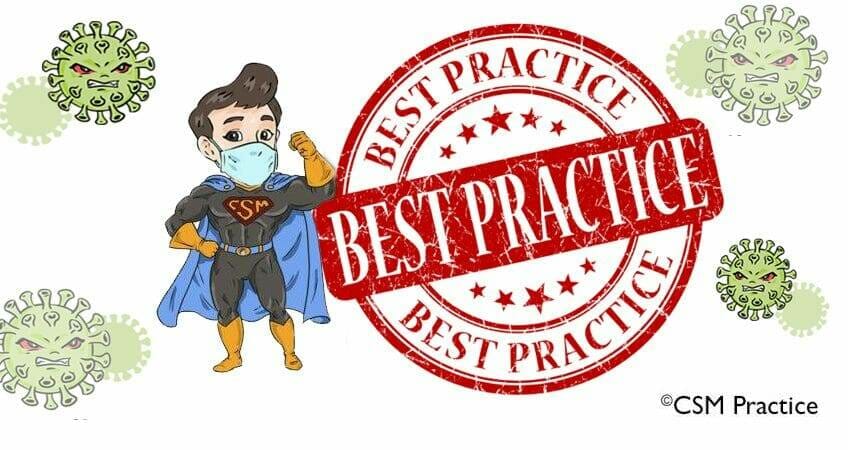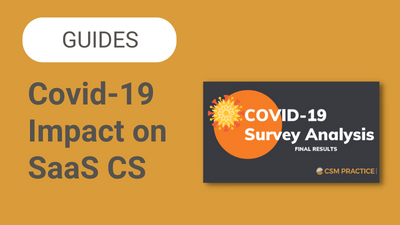In the wake of a slow economy, businesses are struggling to adapt to the resulting economic downturn. To those of us in customer success, it is even more clear that the economic changes caused an unprecedented shift that is already affecting our customers, their journeys, their expected business outcomes, and our ability to fulfill them.
Customer success managers now need to find creative ways to engage customers while thinking deeply about what their new needs might be. At CSM Practice, we are following the economic situation and its impact on customer success closely. And as we collectively work together to lower the curve, we would like to provide some guidance based on best practices to smoothen customer journeys during an economic downturn.
1. Be Customer-Centric
Recent research by Gainsight has shown that 65-80% of companies are on a hiring freeze for the next few months, 30-45% have halted hiring indefinitely, and 60-70% of sales leaders polled reported a delay in sales cycles. These numbers are an indication that sales are slowing down. Depending on the industry, it may cost even more to gain a new customer than to keep an existing customer. Retaining existing customers has always been an essential duty for customer success managers, and now it has become even more important. SaaS companies also need to shift their focus to customer success and operationalize customer-centricity.
● Get Updates about your Customer
Apart from downsizing, your customers may have adapted to the situation by changing their business goals. Customer success managers need to keep tabs on changing customer needs and customer news in a scalable way to quickly identify and align service offerings with the new expected business outcomes.
● Get Everyone Involved
Customer centricity doesn’t apply to customer success alone. Focus all your teams, including marketing, product development, engineering, and support on delivering even more value to existing customers. These teams should be allowed access to direct customer feedback and data, so they understand their needs and act on it.
● Listen More, Respond Immediately
Customer success managers and other customer-facing teams should be more attentive to customer questions to capture their new goals. In such a fluid situation, the knowledge base should be updated often with new customer questions. SaaS businesses must also be prepared to make quick changes to their offering in favor of customer needs as we navigate these uncertain times. Keep in mind that customers can be a source of new ideas, and acting on their comments makes them feel more valued.
1. Communicate with Your Customers
Communication is a two-way process, so as you listen to your customers, you need to handle your outreaches properly. Proper communication can help businesses build trust with their customers, making them easier to retain. Below are some proven ways to communicate with your customers successfully:
● Be Brief
Your customers are probably flooded with a vast amount of information from multiple businesses at the moment. Hence, it is a good idea to keep all communications short and clear. Eliminate unnecessary information and simplify instructions, so your customers can easily follow through without feeling overwhelmed.
● Communicate Company Updates
Inform your customers about how you’re responding to the new economic situation. Any deviation from the usual way of conducting business that may affect your customers should be communicated as well. New ways to contact support and customer success managers or updated business hours are essential information for your customers. Lastly, be sure to ask how you can support them during this period.
● Reach Out to Key Stakeholders
Send personalized emails to key stakeholders in your customer’s company from top executives in your organization. Prioritize outreach to your executive sponsors or champions to reassure them about business continuity and outline your plan to deliver value to their business.
2. Engage Customers Across Multiple Channels
As you execute your communication strategies through emails, you can creatively engage your customers through other channels. These channels can complement your emails if they’re not sufficient or serve as alternatives.
● Send In-app Messages and Alerts
In-app outreaches are suitable for users that don’t engage with your emails. Through in-app banners and messages, you can effectively grab their attention and communicate your company updates. Your solution can also incorporate alerts for emergencies or special offers.
● Take Advantage of Video
Video chat is a streamlined and more efficient way to engage your most strategic customers. Customer success managers can speak directly with champions to better understand their new goals and offer recommendations on how to drive results. Renewal conversations may be more difficult through emails only due to financial constraints, and a quick video chat can help customer success managers hit the right note.
Video is also useful for customers that have gone dark on you. Customer success managers can summarize all the outreaches they missed, present small business reviews, and communicate essential updates in a five-minute video message. Another efficient way to use video is through webinars to highlight product use cases or useful features related to the situation.
● Meet Customers For 1:1 Appointments
Customer success managers may wish to visit new, at-risk, or strategic customers, to strengthen relationships and capture business risks or opportunities. Such meetings will make your customer feel valued, especially because they are now rare. Video chat is a suitable alternative when budgets for travel are tight.
3. Adjust Your Metrics and KPIs
Customers are reacting to the slowdown in the economy in different ways, and it is safe to say that everyone has been affected to some degree, whether positively or negatively. Therefore, metrics that have been used to track customer success, and the corresponding playbooks, need some adjustment.
● Shift Your Focus
Focus on leading indicators of customer success, such as product usage and adoption, to quickly understand your customer’s situation and redesign playbooks. You should also prioritize data that helps you understand the root causes of customer complaints or problems to avoid repeating them. Tighten the metrics you report on and focus on those that are critical to customer success. Overall, it is best to work with metrics from the customer’s point of view to repair their journeys effectively.
● Track Product Usage
One of the most important indicators of your customer’s situation is the level of usage of your product. Look out for customers that have been active in the last few weeks, those that have increased or decreased their usage, and those that have fully adopted your new offerings. You can safely assume that customers with little to no recent usage and no recent engagement with customer success managers are at risk of churn.
● Assess Client’s Health
Health scores are designed to be an early warning of churn. Previously healthy customers may now be struggling and vice versa, so your scoring system should reflect your customers’ changing situations and behaviors. To do this, you can reiterate your present health score or create a new one based on new data. Here are a few relevant health score components that you should prioritize:
- Product Usage and Adoption: A shift in consumption may indicate a change in customer health.
- Business Category: Has your customer’s industry been affected positively or negatively by the slow economy?
- Customer’s Finances: Check for customer financial reports to understand the state of their business.
- CSM sentiment: Take input from customer success managers based on their informed sentiment.
- Other Data-driven Components: Such as outcomes achieved and support ticket activity, in the past 30 days.
Your new health scores can be based on a single component or a combination of multiple metrics. If you use multiple metrics, you can either give each metric an equal weight or weigh them according to their importance in driving customer success for your customers.
● Update your Segments and Success Plays
Your previous customer segments also need to be updated in the face of new data. Since retention is the goal, you may want to create new customer segments based on customer health. New retention success plays such as payment plans and discounts should be developed for at-risk customers. On the other hand, healthy customers with higher product and feature usage may benefit from expansion plans. You can also repackage your offers and features to tackle the needs of different customer segments.
4. Be Flexible on Payment
Some businesses may have lost all or part of their income and may need to cut expenses. This means that many customers are likely to churn for financial reasons. Customer success managers must use available customer data, support tickets, and customer health scores to proactively identify these customers and create plans to retain them. Customer success managers can then offer flexible payment options to cost-sensitive customers to alleviate financial pressure.
Here are some flexible payment options that customer success managers can use to save at-risk accounts due to due payments:
● Payment Extensions
Increase your payment extension window at no extra charge to give customer success managers more time to align your services with the new business goals of defaulting customers.
● Defer Payments
You can defer renewal payments for up to 2 quarters until its more convenient for customers to pay. When the crisis is over, you can bill them twice for missed payments.
● Defer Billing
It costs more to gain a new customer than to keep an existing customer. For that reason, billing for new customers that are about to churn can be postponed for up to 2 quarters. This option offers a win-win situation for SaaS businesses and their new customers.
● Temporary Downsell
Rather than losing the customers, you can work with them to minimize the number of features they subscribe to reduce costs. You can agree on a later time to return them to a full-service subscription.
● X Months Grace Period
For clients that have 2-year contracts or longer, renewing at such a critical time may be a challenge. SaaS businesses can offer an X number of months during which they can use the products for free without any financial or contractual risk. At the end of X months, they can reconsider their position or hopefully renew their contracts.
● Discounts and Free Features
You can offer generous discounts or free features that may be beneficial to specific customer segments or to encourage certain behavior such as early renewal. If there is little engagement with these promotions, you can use in-app notifications to get it in front of all your customers.
In return for your flexibility, you can encourage beneficiaries to:
- Share their success stories
- Attend a webinar to drive more value
- Prolong their contract
- Become advocates or join your ambassador program
 5. Encourage Productivity
5. Encourage Productivity
Customer success managers must be proactive and productive during this downturn to perform their retention duties while driving value to your customer base. Simplify and streamline customer success managers’ processes, add some automation, and involve other teams to prevent customer success manager burnout.
● Combine Data Sources for Customer Success Managers
Combine data sources that would be otherwise spread across multiple teams so customer success managers can access customer data faster.
● Conduct Risk Escalation Meetings
Before things get out of hand, set up meetings where customer success managers can collaborate with other team members to proactively develop success plays for at-risk customers, and gain executive support.
● Restructure Customer Success Manager Compensation
SaaS businesses that offer variable payment plans can restructure the compensation plan for customer success managers to reflect their focus on retention instead of expansion.
Summary
Drastic changes in the economy will have a massive impact on customer journeys and finances. To salvage the situation, SaaS businesses and customer success managers must put the customer at the center of their strategies. Since expansion opportunities are limited, the majority of customer success efforts should be targeted at retaining existing customers, realigning the service offerings to their new expected business outcomes, and delivering without compromise.
If you need help with retaining customers during this crisis, you can contact CSM Practice for more actionable insights.






 5. Encourage Productivity
5. Encourage Productivity
January 16, 2021
Wow, this piece of writing is pleasant, my sister is analyzing these things, thus I am going to inform her.|
January 16, 2021
Thank you for your appreciation. We acknowledge your ideas and opinions. Please sign up for our newsletter. Here’s the link: Click Here to Sign up
February 7, 2021
I discovered your blog site on google and check a few of your early posts. Continue to keep up the very good operate. I just additional up your RSS feed to my MSN News Reader. Seeking forward to reading more from you later on!…
February 8, 2021
Happy you found this to be a good read. Here’s a link for our newsletter should you wish to sign up: Click Here to Sign up